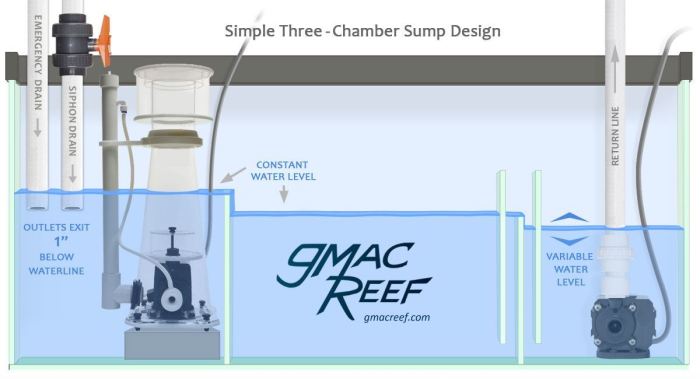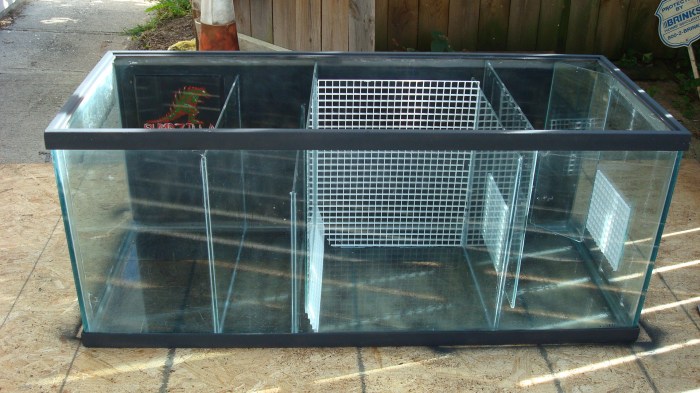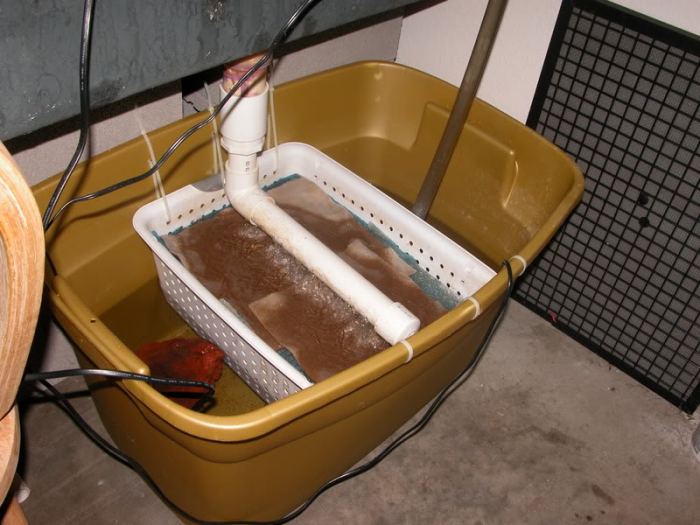DIY Sump sets the stage for this informative journey, guiding you through the world of basement water management. Whether you’re dealing with a chronic problem or simply want to prepare for the unexpected, understanding how to install, maintain, and even upgrade a sump pump is essential.
From choosing the right pump to troubleshooting common issues, we’ll cover everything you need to know to keep your basement dry and your peace of mind intact.
DIY Sump Pump Installation
Installing a sump pump is a crucial step in protecting your basement from water damage. This guide provides a comprehensive overview of the installation process, ensuring you can effectively safeguard your home.
Preparing the Sump Pit
Before installing the sump pump, you need to prepare the sump pit. This involves ensuring the pit is clean, properly sized, and in good condition.
- Remove any debris or sediment from the sump pit. This will prevent the pump from clogging and ensure efficient operation.
- Inspect the sump pit for cracks or damage. Repair any damage before installing the pump.
- Ensure the sump pit is the correct size for the pump you are installing. The pit should be large enough to accommodate the pump and allow for proper water flow.
Connecting the Pump to the Discharge Pipe
The discharge pipe carries water away from the sump pit to a safe location, usually a drain or sewer line. Connecting the pump to the discharge pipe is a critical step in the installation process.
- Connect the discharge pipe to the pump outlet. Use a pipe clamp or other appropriate connector to ensure a secure connection.
- Route the discharge pipe to the desired location. Ensure the pipe is sloped downward to allow gravity to assist in water drainage.
- Secure the discharge pipe to the wall or floor using pipe straps or other suitable methods. This will prevent the pipe from moving or becoming disconnected.
Testing the System
Once the sump pump is installed, it’s essential to test the system to ensure it’s working correctly.
- Pour water into the sump pit to activate the pump. This will ensure the pump is functioning properly and water is being discharged correctly.
- Check for leaks in the system. Ensure all connections are tight and there are no signs of water leakage.
- Observe the pump’s operation. Listen for any unusual noises or vibrations. If you notice any problems, address them immediately.
Tools and Materials
You will need the following tools and materials to install a sump pump:
- Sump pump
- Discharge pipe (PVC or ABS)
- Pipe clamps or connectors
- Pipe straps
- Screwdriver
- Wrench
- Level
- Measuring tape
- Safety glasses
- Work gloves
Choosing the Right Sump Pump

A sump pump is an essential component of a basement waterproofing system, working tirelessly to remove excess water and prevent flooding. Selecting the right sump pump for your needs is crucial to ensure proper protection and peace of mind. To choose the best sump pump, you’ll need to consider several factors, including its horsepower, flow rate, and discharge height.
Sump Pump Types and Features
Understanding the different types of sump pumps and their features is crucial in making the right choice. Here’s a comparison table to help you navigate the options:
| Pump Type | Features | Pros | Cons |
|—|—|—|—|
| Submersible Sump Pump | * Completely submerged in the sump pit * * Quiet operation * * Long lifespan * * Easy installation | * More powerful than pedestal pumps * * Less prone to clogging * * Less maintenance required | * More expensive than pedestal pumps * * Requires a deeper sump pit |
| Pedestal Sump Pump | * Mounted above the sump pit * * Less expensive than submersible pumps * * Easy to access for maintenance | * Noisier than submersible pumps * * More prone to clogging * * Shorter lifespan |
| Battery Backup Sump Pump | * Operates on a battery in case of power outages * * Provides protection against flooding during power outages | * More expensive than standard sump pumps * * Requires regular battery maintenance |
| Combination Sump Pump | * Combines a primary pump with a backup pump * * Provides redundancy in case of pump failure | * More expensive than single-pump systems * * More complex installation |
Factors to Consider When Choosing a Sump Pump
- Horsepower: Horsepower determines the pump’s power and capacity to move water. A higher horsepower pump is better for larger basements or areas with high water infiltration.
- Flow Rate: Flow rate refers to the amount of water the pump can move per minute (gallons per minute or GPM). A higher flow rate is necessary for larger basements or areas with heavy water inflow.
- Discharge Height: Discharge height refers to the vertical distance the pump can lift water. This is important if the discharge pipe needs to go up to a higher level, like a roof drain.
Determining the Appropriate Size and Capacity
To determine the appropriate size and capacity for a sump pump, consider the following:
- Basement Size: A larger basement will require a more powerful sump pump to handle potential water infiltration.
- Water Infiltration Risk: The risk of water infiltration is a key factor. Areas with high water table levels or frequent heavy rainfall require more powerful pumps.
- Sump Pit Size: The sump pit should be large enough to accommodate the pump and allow for adequate water storage before the pump activates.
Sump Pump Safety Considerations

Sump pumps are essential for protecting your home from water damage, but they also pose safety risks if not handled properly. It’s crucial to understand and follow safety guidelines to minimize the risk of accidents and ensure the safe operation of your sump pump.
Electrical Safety
Proper grounding and electrical wiring are paramount for sump pump safety. A properly grounded sump pump minimizes the risk of electrical shocks, which can be fatal. The electrical wiring should be installed by a qualified electrician, ensuring compliance with local electrical codes.
- Use a dedicated circuit for your sump pump. Avoid overloading the circuit with other appliances, which can lead to overheating and electrical hazards.
- Inspect the wiring and connections regularly for signs of damage or wear. Replace any damaged or worn components immediately.
- Never touch a sump pump or its wiring with wet hands. Always use dry hands and tools when working with electrical equipment.
Working with Sump Pumps
- Always wear appropriate safety gear, including rubber-soled shoes and gloves, when working around the sump pump. This will protect you from electrical shocks and contact with contaminated water.
- Avoid contact with water in the sump pit. The water may be contaminated with sewage or other hazardous materials.
- Never operate a sump pump with a damaged cord or plug. Replace any damaged components immediately.
- Ensure the sump pump is properly secured and cannot be accidentally dislodged or tipped over.
- Regularly check the sump pump’s discharge pipe for blockages. Clear any blockages immediately to prevent water from backing up into your basement.
Sump Pump Malfunctions, Diy sump
Sump pump malfunctions can lead to serious water damage and health risks.
- A malfunctioning sump pump can cause water to accumulate in your basement, leading to mold growth and other health hazards. Mold can trigger respiratory problems, especially in individuals with allergies or asthma.
- Water damage can also weaken structural supports, potentially leading to building collapses.
- Regularly inspect your sump pump for signs of wear and tear. This includes checking the pump’s motor, impeller, and float switch.
- Test your sump pump regularly by pouring water into the sump pit to ensure it is working properly. This is particularly important during periods of heavy rainfall.
- Consider installing a backup sump pump system for added protection. This will provide a secondary pump in case the primary pump fails.
DIY Sump Pump Projects

While a basic sump pump system effectively removes water, there’s always room for improvement in terms of efficiency, aesthetics, and integration with your basement design. These DIY projects can help you optimize your sump pump system and enhance your basement’s overall appeal.
Custom Sump Pit Cover
A custom sump pit cover can improve the appearance of your basement while providing additional safety and functionality. Here are some ideas for building a custom sump pit cover:
* Materials: Consider using durable materials like plywood, concrete, or composite decking for the cover’s base. For the top, you can choose a material that complements your basement’s design, such as tile, carpet, or even a decorative concrete overlay.
* Design: You can design a cover that seamlessly blends with your basement floor or add a decorative element, like a custom-cut design or a built-in step for easier access to the sump pump.
* Functionality: You can incorporate features like a hinged lid for easy access to the sump pump, a built-in air vent for ventilation, or even a small storage compartment for emergency supplies.
* Safety: Ensure the cover is strong enough to support weight and consider adding a safety latch to prevent accidental falls into the sump pit.
Decorative Enclosure for the Sump Pump
A decorative enclosure can help conceal the sump pump and enhance the aesthetic appeal of your basement.
* Materials: Use materials like wood, drywall, or even decorative panels to create a visually appealing enclosure.
* Design: You can customize the design to match your basement’s style. Consider incorporating a decorative door, a built-in shelf, or even a custom-painted mural.
* Functionality: Ensure the enclosure provides adequate ventilation to prevent moisture buildup around the pump.
Integrating the Sump Pump into the Basement Design
Integrating the sump pump into your basement design can create a more cohesive and functional space.
* Placement: Consider strategic placement of the sump pump to minimize its visual impact. You can locate it behind a freestanding bookshelf, in a corner, or even under a staircase.
* Camouflage: Use a decorative screen or a strategically placed plant to mask the sump pump from view.
* Lighting: Use accent lighting to highlight the area around the sump pump, creating a more inviting and functional space.
DIY Sump Pump Project Examples
Ready to take your sump pump knowledge to the next level? Let’s explore some practical DIY projects that can enhance your basement’s protection and peace of mind. These projects are designed to be achievable for homeowners with basic DIY skills and tools.
Building a Custom Sump Pit Cover
A custom sump pit cover not only enhances aesthetics but also adds a layer of safety. It can help prevent accidental falls into the pit and keep debris out.
Here’s a step-by-step guide:
* Materials:
* Plywood or treated lumber for the cover base
* Waterproof sealant
* Hinges and a latch for easy access
* Optional: Decorative tile, paint, or other finishing materials
* Tools:
* Saw (circular or jigsaw)
* Drill
* Level
* Measuring tape
* Safety glasses and gloves
* Steps:
* Measure the sump pit opening: Ensure a snug fit with a small gap for easy access.
* Cut the cover base: Use a saw to cut the plywood or lumber to the desired size.
* Apply sealant: Seal the edges and any gaps in the cover base to prevent moisture from seeping in.
* Attach hinges and latch: Install the hinges on the cover base and the latch on the wall or framing around the sump pit.
* Finish the cover: Paint, tile, or add other decorative elements to create a custom look.
* Example: A homeowner with a concrete sump pit installed a custom cover made from treated lumber. They painted the cover to match the basement floor, creating a seamless and aesthetically pleasing look.
Installing a Backup Battery System
A backup battery system provides peace of mind during power outages, ensuring your sump pump continues to operate and protect your basement.
Here’s how to install one:
* Materials:
* Battery backup system (choose a system with enough capacity for your pump’s power requirements)
* Wiring and connectors (compatible with the backup system and your pump)
* Safety equipment (circuit breaker, GFCI outlet)
* Tools:
* Wire strippers
* Crimping tool
* Screwdriver
* Voltage tester
* Steps:
* Choose a location: Install the battery backup system in a dry and easily accessible location.
* Connect the wiring: Follow the manufacturer’s instructions to connect the wiring between the backup system, the pump, and the power source.
* Test the system: After installation, test the backup system by simulating a power outage.
* Example: A homeowner installed a battery backup system for their sump pump after experiencing a power outage during a heavy rainstorm. The system provided crucial protection during the outage, preventing water damage.
A well-functioning DIY sump system can provide invaluable peace of mind, knowing that your basement is protected from the threat of water damage. With a little knowledge and effort, you can confidently tackle this essential home improvement project and ensure a dry and comfortable living space for years to come.
DIY projects can be incredibly rewarding, whether you’re building a sump pump system or crafting a fun costume. If you’re looking for a creative project, why not try making a Jessie DIY costume ? It’s a great way to tap into your inner creativity and impress your friends. And once you’ve mastered the art of crafting, you can move on to more complex DIY projects like building a sump pump for your basement.
